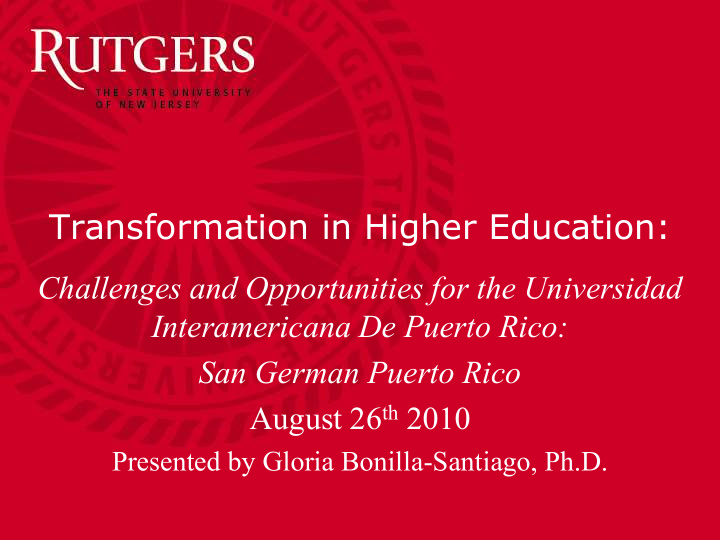



Transformation in Higher Education: Challenges and Opportunities for the Universidad Interamericana De Puerto Rico: San German Puerto Rico August 26 th 2010 Presented by Gloria Bonilla-Santiago, Ph.D.
Agenda • 8:00 - 9:00 a.m. – Introductions • 9:00-10:30 am. – Leading Change Assessment Tool • 10:30-10:45am. – Break • 11:00 a.m. -12:00 pm – Transformation on Higher Education • 12:00 – 1:30 – Lunch
• 1:30 – 3:00 p.m. – Faculty discussions Teams on Modelo de Transformacion Integral • 3:00-4:00 pm – Faculty Presentations Program closure
LEADING CHANGE AT EVERY LEVEL 4
PURPOSE …is to help individuals identify and develop the skills that will make them more effective at leading change, whether the change is one they have chosen to initiate or one they have been asked to implement. 5
LEADING CHANGE WHEN YOU’RE NOT THE CEO Change comes about when followers themselves desire it and seek it. Hence the role of the leader is to enlist the participation of others as leaders of the effort. That is the sum and essence not only of leading change but also of good management in general. (O’Toole, 1995,p.133) 6
MODELING THE CHANGE “To overcome the resistance to change , one must be willing, for starters, to change oneself.” 7
DIMENSIONS OF LEADING CHANGE Modeling the Change Communicating about the Change. Involving others in the change. Helping others break from the past. Creating a supportive learning environment. 8
WAYS TO MODEL THE CHANGE Map the change objectives to your daily responsibilities. Think before you act. Audit your past actions. Monitor and correct yourself. Enlist a shadow. Be alert to subtle cues from others about your behavior. 9
WAYS TO COMMUNICATE ABOUT THE CHANGE Communicate with a variety of methods. Communicate with a wide audience. Shape possible outcomes and their estimated likelihood. Use metaphors with care. Don’t dictate the way people should feel. 1 0
WAYS TO INVOLVE OTHERS IN THE CHANGE Employ problem-finding. Fully consider other’s ideas. Let others know what happened to their ideas. Practice empathic and non- defensive listening. 1 1
WAYS TO INVOLVE OTHERS IN THE CHANGE Ask effective questions. Utilize technology to bridge physical distance. Organize a large group meeting. 1 2
WAYS TO HELP OTHERS BREAK FROM THE PAST Play the devil’s advocate. Support innovation. Sponsor wild ideas. Demand continuous improvement. Stage a symbolic break with the past. 1 3
WAYS TO CREATIVE A SUPPORTIVE LEARNING ENVIRONMENT Focus attention away from blame and toward problem correction. Admit what you don’t know. Declare a practice zone. Support time for training. 1 4
150 Overall Effectiveness at Leading Change 135 120 115 105 90 75 60 45 30 Communicating Creating a Involving others Helping others Modeling the about the supportive learning in the change break from the Change change environment past 1 5
TRANSFORMATIONAL MODELS FOR THE UNIVERSITIES OF THE FUTURE
Global University Source: A Choice of Transformations for the 21st-Century University, James J. Duderstadt: The Chronicle of Higher education Opinion & Arts. From the issue dated February 4, 2000
The Diverse University Draw’s its intellectual strength and character from the rich diversity of humankind, and provide an environment in which people respect and tolerate diversity in living, working, and learning together as scholars.
The Creative University • Some may replace the classroom with the studio, or shift the role of the faculty member from that of a teacher to that of the leader of a creative team.
The Divisionless University • The higher-education institution of the future will be far less specialized and far more integrated. A web of structures, some real and some virtual, will provide both horizontal and Vertical integration among the disciplines.
Cyberspace University • As distributed virtual environments become more common, we might even conceive of a time when the classroom experience itself becomes a commodity, provided to anyone, anywhere, anytime -- for a price.
Adult University • An adult-university approach would relieve research institutions of the responsibilities of general education and parenting -- roles for which many are not well suited, because their faculty members concentrate more on scholarship than on guiding the intellectual and emotional maturation of students.
Institutions would design programs to bring together students with alumni who have established themselves in particular careers -- thereby blurring the distinction between student and graduate, between the college and the external world.
Ubiquitous University Ubiquitous universities will be new social life-forms, capable of providing community learning centers and knowledge networks that are open and available to all.
Laboratory University A testing site where new models would be developed and studied.
Misión Excelencia Calidad Enseñanza – Aprendizaje – Investigación Tecnología Estudiantes Tecnología Servicios de Apoyo - Facilitadores Mejoramiento Continuo Aprendizaje Continuo Desarrollo Profesional Estructura Académica Estructura Administrativa Procesos Procesos Administrativos Académicos Avalúo Planificación Estratégica Currículo “Assessment” Personal Facultad Administrativo Liderato Académico y Administrativo Yo soy la Inter y tú… ¿qué esperas? www.sg.inter.edu
1. What are your reactions and your general overview of the model? 2. What improvements are needed in order to implement change needed? 3. What do faculty need in order to take ownership of the model? 4. How do we sustain long-term changes and institutionalized improvements? 5. When do we take ownership of the process and begin implementation? Yo soy la Inter y tú… ¿qué esperas? www.sg.inter.edu
Recommend
More recommend